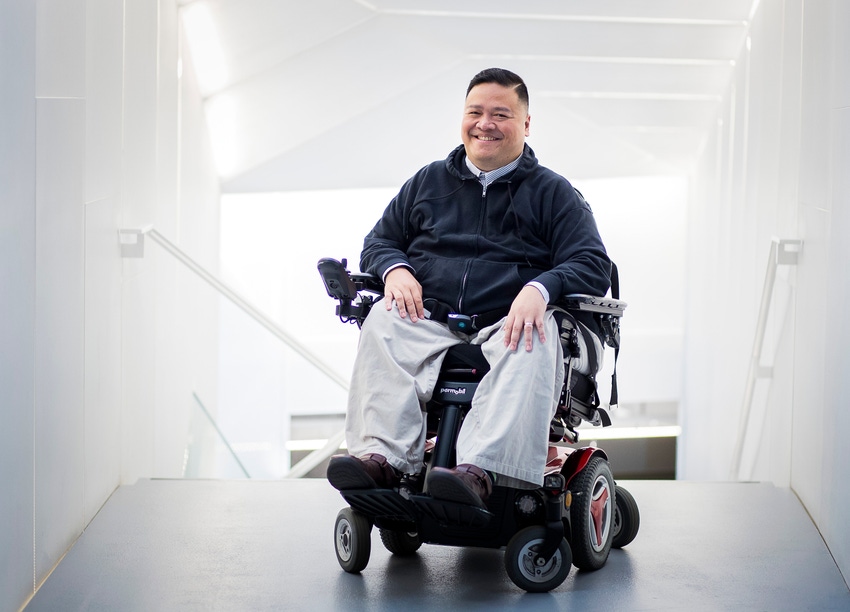Foundation encourages engineers and designers to use electronics, materials science, machine learning, and even AI to find new and better ways for wheelchair users to live their everyday lives.
August 10, 2018

A new survey is prompting wheelchair users to call for more innovation to help them fulfill their potential in the workplace.
The survey, commissioned by the Toyota Mobility Foundation, showed that 92% of respondents have had problems working or finding a job as a direct result of their wheelchair and 36% have been unable to work at all for the same reason. The foundation is calling on engineers and designers, as well as software and data science experts, to find better solutions for people with lower-limb paralysis.
“The challenge is to start thinking beyond the status quo,” August de los Reyes, a director of user experience on the Search, Assistant, and News Ecosystem at Google, Inc., told Design News. “There’s a great opportunity to innovate in this space, whether it’s at the component level, the device level, or in the entire system of transportation.”
The survey painted a stark picture of the work-related problems facing wheelchair users. It noted that wheelchairs and other types of so-called “mobility devices” limited the number of jobs for which users could apply. Approximately a quarter of respondents said they had to become self-employed and 26% said they had to work at home as a result of their wheelchair use.
The Toyota Mobility Foundation wants to change that—not only through the survey, but also by launching a $4 million global challenge for engineers and designers. Known as the Mobility Unlimited Challenge, it will award $500,000 to five finalists to take their concepts to the prototype stage. It will also award $1 million to help bring the winning product to market. The organization has called for entries to be submitted by August 15, 2018 and plans to unveil the winning concept in Tokyo in 2020.
de los Reyes, who serves as a global ambassador for the challenge, said that the goal is to develop better solutions and to raise greater awareness of the need for innovation. The need to innovate is critically important, he said, not only for the 65 million people worldwide who use wheelchairs, but also for the societies that can benefit by making wheelchair users more productive. “The talent pool of people with disabilities is largely untapped,” he said. “Part of the reason it is untapped is because today’s assistive technologies don’t provide, and sometimes actually prevent, people in wheelchairs from accessing opportunities.”
Beyond the ‘Chair on Wheels’
de los Reyes, who is a wheelchair user, compared the state of innovation in wheelchairs to that of the “horseless carriage” market of the early 1900s. Early automobiles were limited by the vocabulary and mental models surrounding them, he said. Similarly, today’s mobility devices have been limited by the idea that all solutions must involve a “chair on wheels.”
|
August de los Reyes of Google: “There’s a great opportunity to innovate in this space, whether it’s at the component level, the device level, or in the entire system of transportation.” (Image source: August de los Reyes) |
The Mobility Unlimited Challenge will encourage engineers and designers to go beyond such limitations. As such, de los Reyes said, developers are urged to think creatively in the areas of material science, electronics, data science, machine learning, and artificial intelligence, among others.
“I would challenge them to think outside the box and beyond the chair,” he said. “Even beyond the exoskeleton.”
As potential innovation examples, de los Reyes cited the use of sensors to locate potholes and unexpected curbs on sidewalks, thereby enabling users to steer around those hazards. Also, the development of lighter weight portable ramps could enable wheelchair users to more easily traverse stairways. And better batteries could help cut the weight of wheelchairs. Today, he said, portable ramps weigh upwards of 100 lbs and powered wheelchairs can be 500 lbs.
He encouraged engineers to employ the best tools at their disposal to conjure up newer and better ideas. “Introducing artificial intelligence and machine learning within a system of actuators and motors could provide new opportunities for mobility,” de los Reyes said.
RELATED ARTICLES:
Often, such innovative new ideas end up benefiting everyone, not just those in wheelchairs, de los Reyes said. “If you look at the curb-cuts in cities, people walk their bikes and baby strollers up them,” he said. “Everyone uses them, even though their original intent was for people in wheelchairs.” Similarly, he noted, delivery drivers and countless commuters make wide use of automatic door openers that were originally intended for wheelchair users.
de los Reyes hopes that a new crop of innovative solutions will have a similarly broad benefit. “This is an urgent call for innovation, not only to help the people who can’t access their opportunities, but also to help economic productivity worldwide,” he said.
Senior technical editor Chuck Murray has been writing about technology for 34 years. He joined Design News in 1987, and has covered electronics, automation, fluid power, and auto.
|
About the Author(s)
You May Also Like





